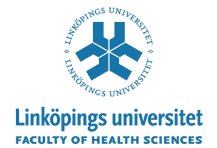|
|
| |
| COURSE TITLE |
| Epidemiology with Biomedical Applications,
7,5 points |
| |
COURSE CATEGORY Programkurs/Fristående kurs
MAIN FIELD OF STUDY
SUBJECT AREA
|
|
COURSE CODE |
|
OMBEPI |
|
| AIM OF THE COURSE |
| The purpose of the course is to provide knowledge in theoretical aspects on epidemiological study design, statistics, causality and validity. Practical epidemiological applications with regard to design, analysis and evaluation of studies on specific topics such as clinical and molecular epidemiology will be covered through lectures as well as group discussions among the students and of their individual research. |
| CONTENTS |
* Background: Study base, rates, causes and inferences, exposure assessments.
* Study design: Cross-sectional, cohort, case-referent, correlation studies.
* Descriptive epidemiology.
* Statistical analyses of epidemiological studies.
* Applications of epidemiology, such as molecular and clinical epidemiology. |
| TEACHING |
Lectures, tutorial groups and seminars.
The educational method used is problem-based learning (PBL). PBL emphasises the student´s development of free, self-supporting, lifelong learning ability as an instrument for critical inquiry. The students own queries and formulated problems form the basis of PBL. Important is also the student´s ability to take responsibility for his/her own learning, and to seek and evaluate information and knowledge and to train co-operation and flexible attitude to different views and ideas. |
| EXAMINATION |
Active participation in tutorial groups and seminars. Oral group presentation and individual written report.
Students, which have not passed on the regular examination occasion, are normally offered four additional opportunities according to this syllabus, one of which is close in time to the first examination occasion. Students who have failed three times on the course or part of the course are entitled to request another examiner at the new examination occasion. |
| ADMISSION REQUIREMENTS |
| Bachelor of Science in Biomedicine or other related subjects such as Medicine or Biology. At least three years of full-time undergraduate studies in a relevant main subject. For students in the Medical Biology Programme, 160 credits: Passed semester 1 to 5. |
| GRADING |
|
| CERTIFICATE |
| |
| COURSE LITERATURE |
| The course literature is decided upon by the department
in question. |
| OTHER INFORMATION |
|
| |
Epidemiology with Biomedical Applications
Epidemiology with Biomedical Applications |
| |
Department responsible
for
the course or
equivalent:
MEDBIO - Medicinsk biologi |
| |
|
|
|
|
|
| Registrar No: |
|
Course Code: OMBEPI |
|
|
|
| |
|
Exam codes: see Local Computer System |
|
|
|
| Subject/Subject Area : |
|
|
|
|
|
| |
|
|
|
|
|
| Level |
|
Education level |
|
|
Subject Area Code |
|
Field of Education |
|
| C |
|
|
|
|
|
|
|
|
|
|
|
|
| |
